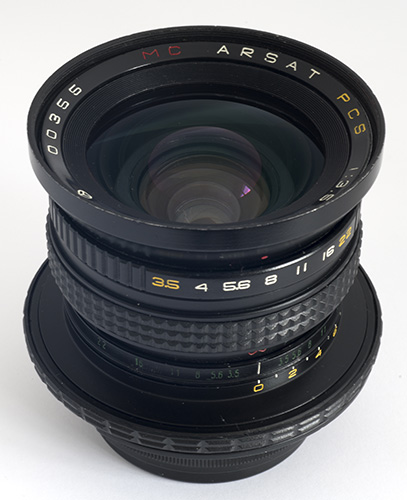
The Arsat 45mm f/3.5 shift lens
[Arsat45pc_01.jpg]
Arsat lenses

On this page we report on the Arsat 45mm shift
lens. Visual examination without disassembling the lens
appears to confirm that – like all the 45mm shift and shift/tilt
lenses advertised for the Pentacon Six mount – this lens is
based on the optical elements of the Mir-26B wide-angle lens. We therefore assume that
the following data is accurate.
| Manufacturer & lens name |
Max aperture & focal length |
Minimum aperture |
Elements / groups | Closest focus m |
Max shift mm |
Filter thread mm |
Length mm |
Weight g |
| Arsat 45mm shift |
f/3.5 / 45 |
f/22 |
8 / 7 |
0.5 |
12 (1) |
82 × 0.75 |
84 (2) |
750 ? (3) |
Notes
(1) With the 45mm shift and
shift/tilt lenses, some vignetting is likely to be observable on
the full 6 × 6 format with shifts in excess of 10mm.
However, in contrast with the Hartblei lenses, on the Arsat 45mm
lens, there is no colour coding to remind users of this.
(2) The rear element of this
lens extends back beyond the rear edge of the lens mount for
Pentacon Six cameras, so the lens should never be stood upright
on its back without a rear lens cap first being fitted in order
to protect the rear element.
(3) It has not yet been possible
to weigh this lens. The Hartblei 45mm shift lens is
reported to weigh 750 g, and the weight of the Arsat lens is
likely to be very similar.
| The Arsat 45mm shift lens has
the designation “MC ARSAT PCS”, the last three letters
apparently standing for “Perspective Control Shift”.
This is a shift-only lens, with no tilt capability.
In the image to the right, it is shown fully
shifted. The nominal maximum shift with all shift
versions of the 45mm Arsenal Mir-26B lens elements is
12mm. However, this particular lens shifts a maximum
of 11.5 mm. As users are advised not to shift the
lens more than 10mm when shooting in the full 6 × 6
format, this should not be viewed as a serious limitation. Arsat has opted for some bright colours for the numerals and text on this lens. On the name ring on the front, the letters “PCS” are in yellow, and this colour is used for the shift distances on the shift ring. I note that on the aperture ring (at the top of the lens in this picture), the largest and smallest apertures (f/3.5 and f/22, respectively) are also in yellow. I did not acquire an operating manual with this lens, and so don’t know if the use of this colour for these aperture values has any significance. Above the numerals on the shift ring, a straight, white vertical line is the index mark both for shifting and for focussing. To either side of this line, numerals are engraved in dark green. These indicate the depth of field at different apertures. However, they are not particularly easy to read because of the dark colour. (For an explanation of how to use the depth of field indicators on lenses, see here.) On the next ring up in this photograph, the infinity mark is in red and the distances in metres are easy to see in large, white numerals. The rubber studded ring in front of these numerals is of course the focussing ring. As on the original (non-shift) Arsenal Mir-26B, the aperture control ring is towards the front of the lens. Again, the numerals are large and clear. Unlike the Arsenal Mir-26B, this Arsat shift version of the lens does have multi-coating, and the letters “MC” are on the front ring, in red, as is common with many manufacturers. Like the 45mm shift and shift/tilt lenses from Hartblei and Wiese, the lens mount rotates – so it is possible to shift down as well as up, sideways, or even in other diagonal directions if required. In all the shift (and shift/tilt) lenses that I have personally handled so far, rotation is the full 360°, with click stops every 15°. With the exception of the rare 55mm Super-Angulon Tilt/Shift lens from Schneider-Kreuznach, all other shift and shift/tilt lenses for the Pentacon Six have a manual preset diaphragm. This 45mm Arsat lens has a détente between the maximum aperture of f/3.5 and the next full aperture position, f/4, and détentes at full and half stops down to f/11, and then only at full stops to f/22. (By contrast, the Hartblei PCS 45mm f/3.5 shift-only lens has détentes at half and full stops throughout its entire range all the way down to f/22.) Focussing, the shift ring and the aperture ring all operate smoothly on this lens. |
|
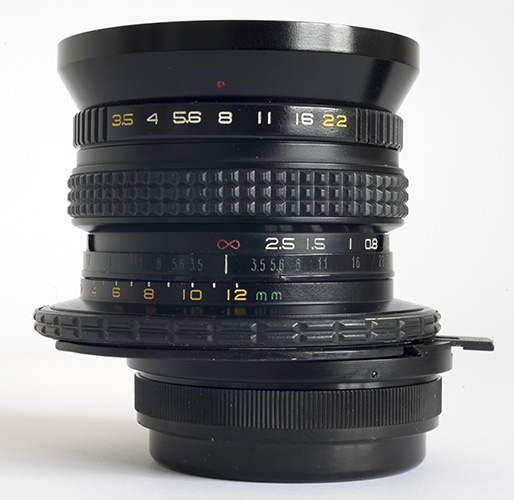 [Arsat45pc_02.jpg] |
Comparison with other 45mm
shift-only lenses
| In
the following pictures, we show the Arsat 45mm shift lens
along with the Wiese and the Hartblei 45mm shift-only
lenses, in all cases in the order, from left to right,
Wiese – Arsat – Hartblei. |
||
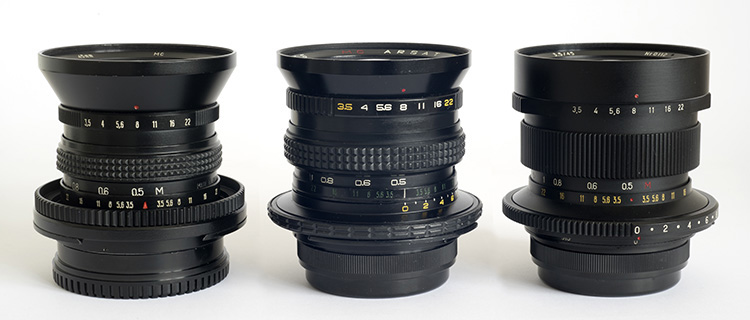 Of these three lenses, the Arsat is the only one that has fitted a rubberised studded cover to the shift ring. [Arsat45pc_06.jpg] |
|
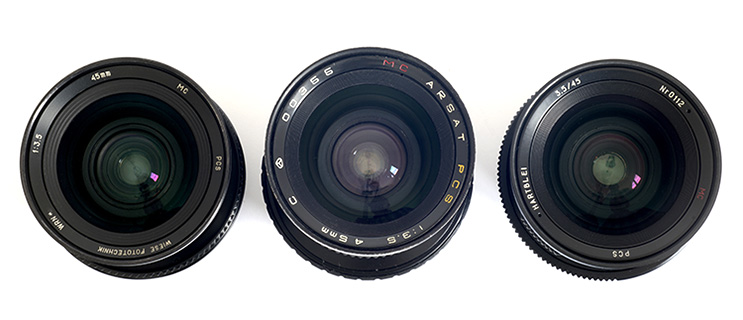 All three lenses are labelled “MC” and “PCS”. [Arsat45pc_05.jpg] |
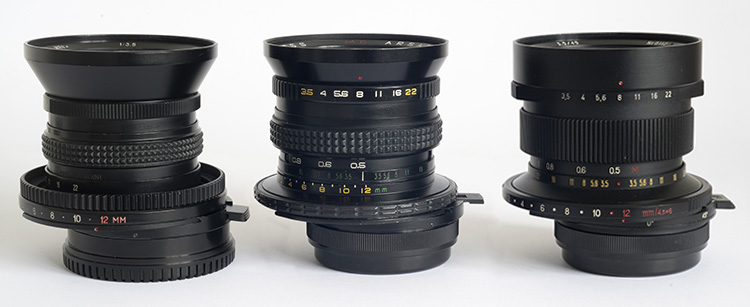 Here, the same three lenses are shown fully shifted. [Arsat45pc_07.jpg] |
|
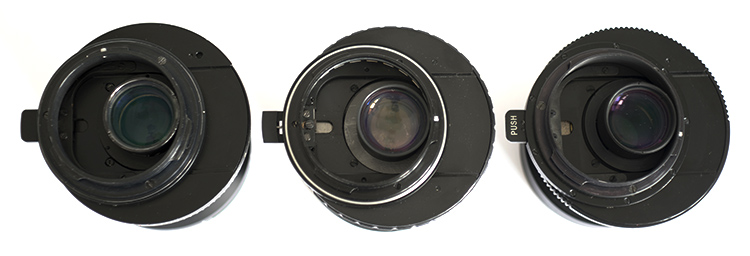 Rear view of the three lenses, fully shifted. The lever on the left in this picture, and on the right in the picture to the left of it, is the release that enables the mount to be rotated, to enable the shift to be made in any direction. Users will find that it is much easier to rotate the lens once it is mounted on the camera. [Arsat45pc_04.jpg] |
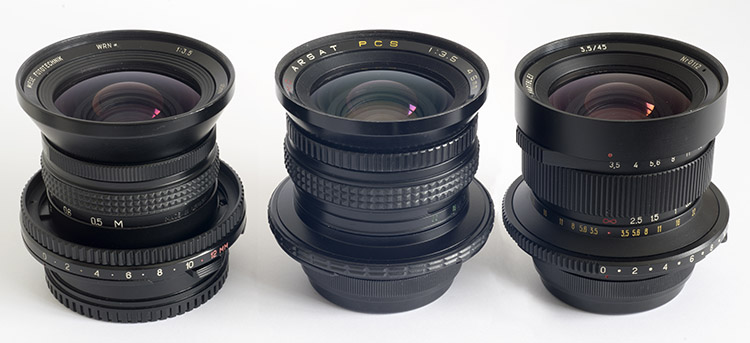 [Arsat45pc_09.jpg] |
|
All three lenses are
multicoated, as can to some extent be seen in this
picture. The multi-coating on the Wiese and Hartblei
lenses appears to be identical, which should not surprise
us, since the two companies worked closely together.
(See more information on this here.)
The Wiese/Hartblei coating appears to be deeper than the
Arsat coating. However, there is almost certainly no
measurable difference in terms of the results obtained
with each of these three lenses. This photograph also shows that the front elements of these three lens all appear to have exactly the same shape – as we would expect, seeing that they are all, apparently, made with the elements of the same Arsenal lens. |
The image to the right of the
rear of the Arsat lens reveals that the Pentacon Six mount
ring has not been anodised black but merely painted
(!!), and that some of the paint has flaked off,
revealing the bare metal beneath. In this detail,
this Arsat lens is far inferior to the Hartblei version,
and such a decision by the manufacturers reveals that at
the time (the year 2000, according to the serial number)
they had not fully overcome the Soviet mentality to what
is acceptable quality.
|
|
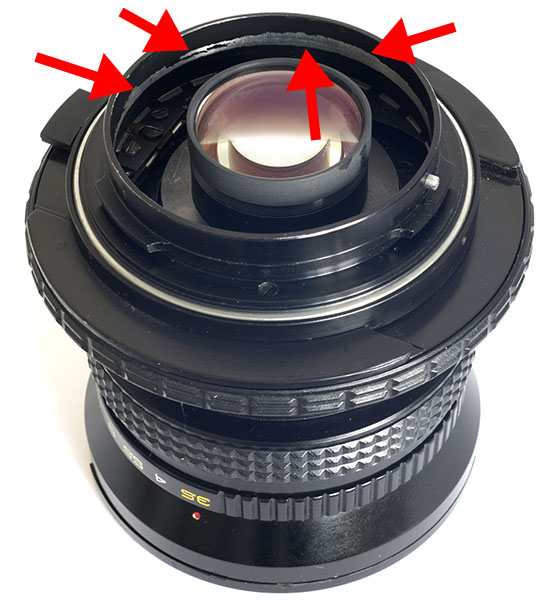 [Arsat45pc_10.jpg] |
| As stated
elsewhere (here), for most
real-world photography with a shift lens, the most
important shift direction is UP, as shift lenses most
often get used for architectural photography, to be able
to include more of the height of a building (ideally, all
of it) without needing to tilt the camera and the lens up,
which would result in converging verticals in the image of
the building – an effect often referred to as
“keystoning”. All of the Ukrainian shift lenses so far seen have a rotating camera mount, with détentes, so that the lens can be rotated through 360 degrees, clicking into a détente slot every 15°. The lens orientation is LOCKED in the chosen position, so that it will not accidently be moved to a different position. To release the lock, the user merely presses a little lever behind the main body of the lens, while rotating the lens to the desired new position. A couple of problems were observed when using this ARSAT shift lens. Problem 1: shift orientation Bearing in mind that virtually the default position of a shift lens is a shift UP, it is convenient if the camera mount is positioned by the manufacturer in such a way that when shift UP is being used, the focussing and aperture index marks are at the TOP of the lens. This is indeed what happens with the Wiese 45mm shift lens. (See more on the Wiese shift lenses here.) However, with the Arsat 45mm lens, in order to shift the lens UP, one has to rotate the lens through 90º, to a point where the focussing and aperture index marks are on the RIGHT of the lens, when viewed from operating position. This makes it much harder to set or check the aperture (or focus, if using the focussing scale that is engraved on the lens). Also, on the Arsat lens, with the mount rotated as above so that the lens shifts up, the degree-of-shift index mark is also on the right. This is because the same index is used for the shift and for the focus. The Wiese lens has a different shift index mark, which is behind the shift ring and so easier for the photographer to see. However, interestingly, and surprisingly, when the Wiese lens is set to shift up, the shift index point on the lens is also not at the top of the lens but on the right, as with the Arsat shift lens. It is clear that these lenses would have been better if the manufacturers had tested the lenses in real-world situations and had incorporated the results of feedback from users. Could any of these problems be simply solved by taking off the Pentacon Six mount and rotating it by 90° before putting it back onto the lens? Unfortunately, no, as (with both these lenses) the mount is held in place with THREE screws, which means that we could rotate it through 120° (or 240°), but not through ninety. Pity. Problem 2: locking mechanism Furthermore, with the Arsat lens, the détentes that prevent the lens from rotating in its mount are not positive enough and the locking lever fails to maintain the lens locked in the chosen orientation. This means that when one is focussing or changing the aperture, one may unwittingly also rotate the whole lens assembly, so that it is no longer located in the desired orientation, for instance, straight UP, but at some other intermediate position, and so shifted in another direction, for instance, diagonally. This is most undesirable, and slows down the user, who has to be constantly checking that the orientation has not moved away from the chosen position. In spite of these operating problems, optically this lens is obviously virtually identical with the other 45mm shift lenses based on the original Mir 26B 45mm wide-angle lens – the only other difference noted that could conceivably affect images being the different types of multi-coating applied to the lenses. However, in actual practice, no differences have been observed in the image quality of the results obtained with any of these lenses that have so far been tested. So let as look at some typical results obtained with this particular example of the Arsat 45mm shift lens. Both pictures taken with a Pentacon Six using Fuji NP160 PRO negative film. Exposure: 1/125 sec f/22, hand-held. Lens shifted 6mm up. |
|||
| |
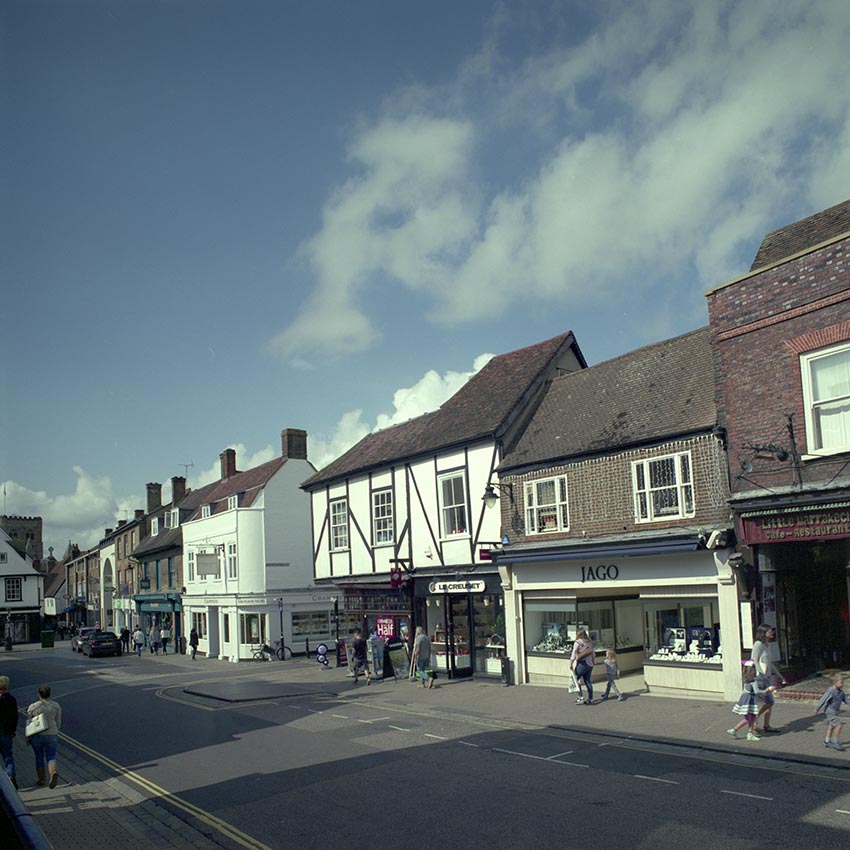 With a 6mm shift up we observe no vignetting (darkening of the corners) with this lens. The camera was clearly not held fully horizontally for this shot. [C562_7s.jpg] |
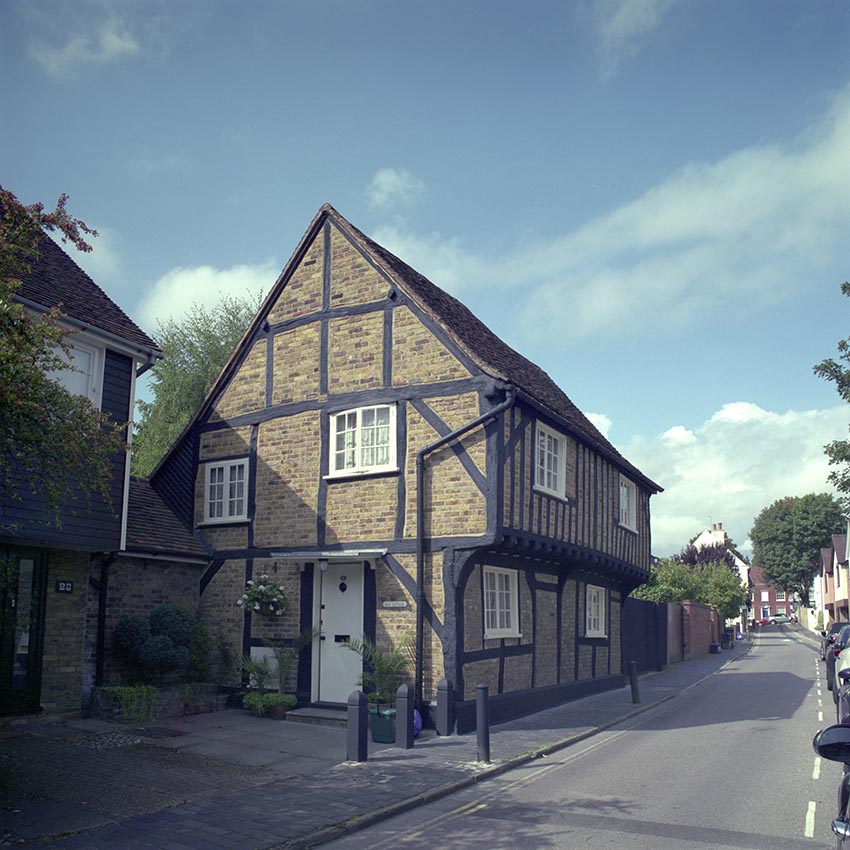 Here the camera angle is better. We would do better to crop out the cars on the right-hand edge. In fact, the lab prints (not reproduced here) have done this automatically, apart from the edge of one mirror. As usual, I have scanned a larger area of the negative than that which is seen in enlargers or slide mounts. [C572_9s.jpg] |
|
| Conclusion The images achieved with this Arsat 45mm shift lens are fully satisfactory (when the camera is correctly held, parallel to the subject!). Even with architectural shots such as these, we do not observe any barrel distortion or other defects. Highly recommended, when used carefully (a requirement when using any shift lens!). |
|||
Back to beginning of the Lens Data section
© TRA August 2017 Latest revision: October 2018